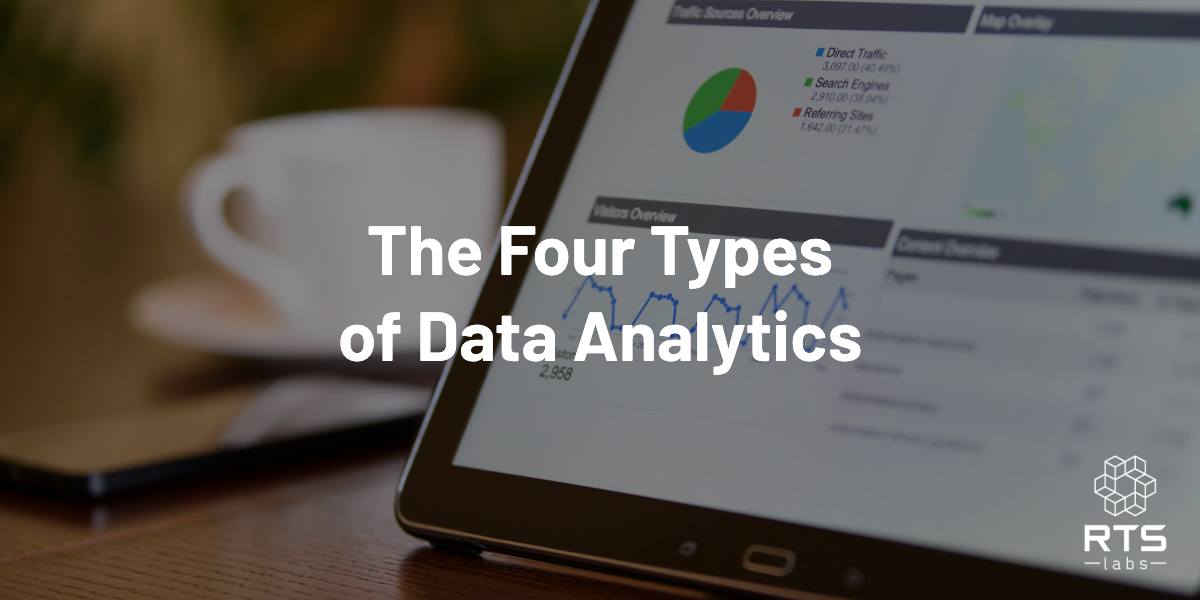We love data at RTS Labs. It helps us and our clients make informed decisions, measure success, and plan for the future. But data is useless when you don’t know what to do with it. When you look at the 4 types of data analytics and how each kind can help you uncover insights for your business, you also see how these four types of analytics build off each other to provide you with a full picture – past, present, and future – of your business.
Using data analytics is where the real magic happens. Data analytics refers to extracting, transforming, modeling, and drawing conclusions from data in order to make decisions. Here’s the thing. There’s more than one type of data analytics. When it comes to data science, there are actually four types: descriptive, diagnostic, predictive and prescriptive.
What are the differences – and which kind of data do you use when – and to solve what kinds of problems? Use this quick reference guide to the 4 types of data analytics and how each kind can help you to get started.
Descriptive
Descriptive analytics are exactly like their sound. They tell you what happened. Let’s say you go to the doctor and they check your vitals: your weight (gain or loss), your height, your blood pressure, your resting heart rate, etc. Descriptive analytics are essentially your vitals – the simplest form of data analytics.
For a business, these are the analytics that are essential to reporting. They’re designed to give you the very basics of who, what, where, when, how, and how many. They provide you with key metrics about your business and serve as a basis for which to dive deeper. You’ll find these kinds of analytics in any business intelligence (BI) tool.
Diagnostic
Diagnostic data helps you answer why something happened. It’s used to find dependencies, identify patterns, and solve problems and is built from descriptive data. For example, if you go to the doctor and they uncover a problem, they will run tests to see the root cause of that problem. Diagnostic data works kind of like that, except the tests are run automatically.
Diagnostic data is automatically generated by the various systems you use. Using advanced analytics tools, analysts use this data to drill-down, perform data discovery, data mine, and find correlations that will help answer why something happened. It’s like your health care team diving down to find the root cause of your health woes.
A well-designed BI dashboard gives you the ability to analyze diagnostic data to uncover problems.
Predictive
Predictive analytics help you predict what will happen. Using descriptive and diagnostic analytics, predictive analytics find tendencies, clusters, and exceptions in order to predict future trends. Here’s where our doctor analogy falls apart a little bit though. If your physician took your vitals, test results, health data from wearables, and other similar baseline data about you and then ran that data through artificial intelligence and machine learning programs, she could very likely predict health outcomes for you. Unfortunately, we’re not there yet in the healthcare space – but maybe one day. But that’s what predictive analytics have the potential to do for your business today.
Predictive analytics are power forecasting tools. Looking for trends? Planning for the future? Predictive analytics are what you need. They also enable statistical modeling. They require the use of machine learning and artificial intelligence and can be a huge asset to your business.
Prescriptive
You can probably guess where this one is going. After your physician has taken vitals, run tests, and drilled down to the root of the problem, she prescribes a medication or change in diet and lifestyle. It’s the same for prescriptive analytics. They prescribe what action to take to eliminate a future problem or make the most of a promising trend.
Prescriptive analytics require artificial intelligence and big data. With prescriptive analytics, you’re taking and analyzing large sets of descriptive and predictive data in order to find the best possible outcome.
Choosing the right kinds of data analytics for you
As you can see, these four types of data analytics can provide deep insights that will uncover trends and help you make better decisions – putting you ahead of your competition and making your teams more efficient.
Want to see firsthand how harnessing the power of data analytics can help your business? Download our case study for a clearer picture of how BI and data analytics can play out in a real-world business setting.






